PPP – Bertha and Christian Adolph Matthiensen – Part 2 California
Note regarding names and ages:
As mentioned in previous posts, my Dad (Gerald Robert McNamara) and his Dad (Gerald Anthony McNamara) shared the same first name.
Friends and family had always known Gerald Anthony McNamara as “Mac”. Mac will always be Mac in these PPPs.
When my Dad was born, everyone referred to him as “Bobby” (short name for Robert). This name stuck with him until his early adult years. So, for this piece, that covers his years as a young boy, I will refer to my Dad as “Bobby” because many of the letters and photos I will be showing also use that name for him.
For brevity, ages of people will sometimes be provided in parentheses.
Introduction
In Part I of this story, we left off in the late 1920s. Adolph, Bertha and their son Virgil (14) are still living on E Pierce, and Adolph still owns his auto repair business with Glen W Hammer. It is important to note that this information came from the Council Bluffs directory, which would have been information collected prior to January 1928.
The 1930 US census recorded that all of the following people were living at the home of Bertha’s father, Henry J. Schneckloth, at 15 Thomas Street in Council Bluffs, Iowa:
Adolph (58)
Bertha (56)
Son Virgil (16)
Daughter Hilda (30) and her husband Gerald Anthony McNamara who was best known as “Mac” (33), and their son (and my Dad) Gerald Robert McNamara aka “Bobby” (3).
This was quite the multifamily/four-generation household. When I first saw this I wondered what was going on that all these family members would wind up living together in what was no doubt crowded living arrangements. Just when did this group made up of the Schneckloth/Matthiensen/McNamara families come to live together at 15 Thomas, and why?
From the photos I have found, this most likely occurred around late 1928. It was only now, while researching and writing this PPP, that it dawned on me that it may very well have been a necessity brought on by difficult times.
To fully appreciate this, we need to pause and take a look at what happed after the First World War, and what was happening in the decade that followed the war.
Historical Note:
During the American post World War One years, there was a welcomed economic boon brought on by the export of American goods to a war-ravaged Europe. Production capabilities on all fronts, including agriculture, had been severely damaged. To meet this need, farm production ramped-up in agricultural states like Iowa to supply grain. With the increased production of goods, the American economy soared, and so did the stock market. People from all economic classes were getting caught-up in the new frenzy of investing in the stock market, even to the extent of borrowing money to buy-in.
As the “Roaring 20s” wore on, postwar Europe became more and more self-sufficient, and therefore less reliant on imported American goods. For the farmers in Iowa, that meant a steady reduction of exported grain.
Between 1929 and 1932, worldwide gross domestic product (GDP) fell by an estimated 15%. By historical comparison, worldwide GDP fell by less than 1% from 2008 to 2009 during the “Great Recession”. Unemployment in the United States during the 1930’s rose as high as 23%.
Europe’s declining reliance on American goods was just one of the contributing factors to the fall in stock prices. The falling stock market was bad enough, but the fact that so many people bought stock on credit made matters all the worse. The economic catastrophe that soon followed would become known as “The Great Depression”. It all started in the United States in 1929, and the economic reverberations of this mighty economy in distress caused it to turn into a devastating worldwide event.
Some of the effects of The Great Depression lasted up until the beginning of World War II. It is one of the grand ironies of human history that the Great Depression was a contributing factor to dire economic conditions in Germany, which in no small part led to the rise of Adolf Hitler and the Nazi Party. Then, in the years that followed, it would be the rise in manufacturing to supply the weaponry and logistics for fighting WWII that would fuel the recovery of the post-Great Depression U.S economy.
The price of this ‘recovery’ for the European theater campaign; 20 million lives.
There are a number of lessons in all this. As is famously said, those who do not learn the lessons of history are bound to repeat them.
For these folks living in the agricultural state of Iowa, The Great Depression meant a 60% fall in crop prices, and all the negative knock-on economic effects thereof. This economic upheaval is the most likely reason why Adolph, Bertha, Virgil, Mac, Hilda and Bobby had moved in with Bertha’s father at 15 Thomas Street, and stayed there for about six years.
The Depression was one possible factor for the move. But there may have been other reasons.
Bertha’s mother, and Henry’s wife, Amelia, passed away on December 16, 1928. Cause of death is listed as heart disease. The cause of death on the official certificate states myocarditis, and notes that she had this condition for the past 8 years. The newspaper article says that she had been “ill” since April.
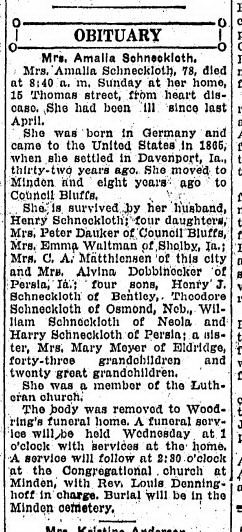 December 17, 1928 edition of the Council Bluffs “Daily Nonpareil” death announcement of Amalia Schneckloth.
December 17, 1928 edition of the Council Bluffs “Daily Nonpareil” death announcement of Amalia Schneckloth.
In 1928 Henry would have been 79 years old. So perhaps Adolph and Bertha had moved in with Henry and Amelia to help take care of them. 14-year-old son Virgil would have naturally come along with them. Also, Adolph and Bertha’s daughter, Hilda, was married to Mac in January of 1925, and their son Bobby was born in October of 1927. No doubt there was some family support considerations, as well financial, that may have played a role in all these folks coming together under one roof.
1928 – 15 Thomas Street, Council Bluffs, Iowa


Bertha and Adolph with their grandson Bobby out front of 15 Thomas Street.
1930s – Council Bluffs

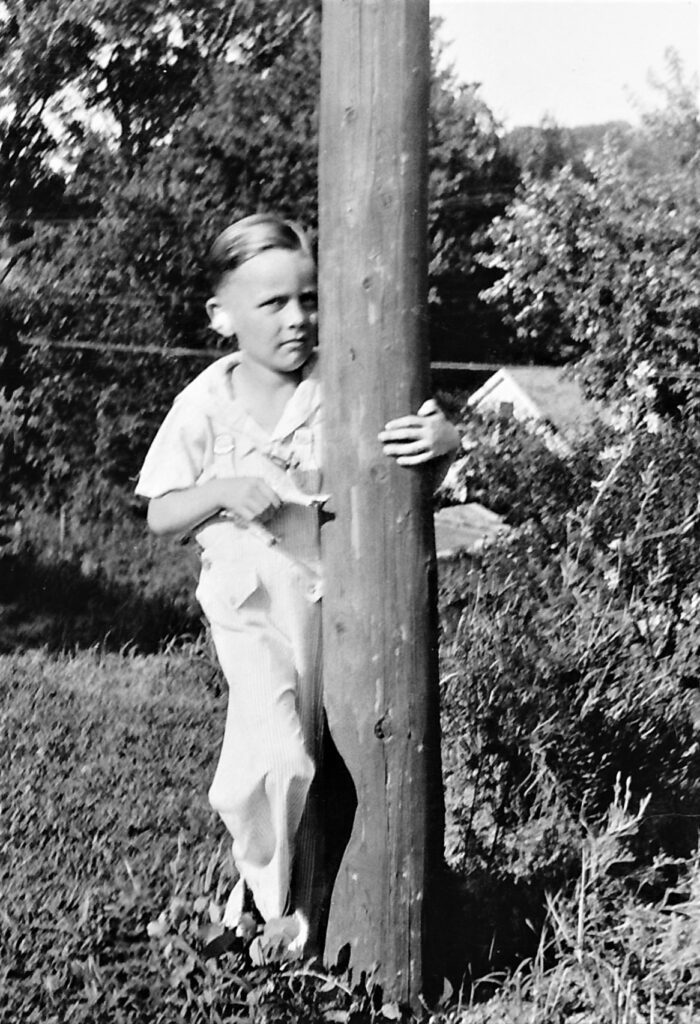
1932 – Left; Bobby with his uncle Virgil Matthiensen (Hilda’s younger brother).
Right; A reserved looking Bobby with what looks like cotton in his ear.
My Dad was said to have had some health issues when he was a boy. As the story goes, his pediatrician told Mac and Hilda that it would be best to have him grow up in a place with better weather.
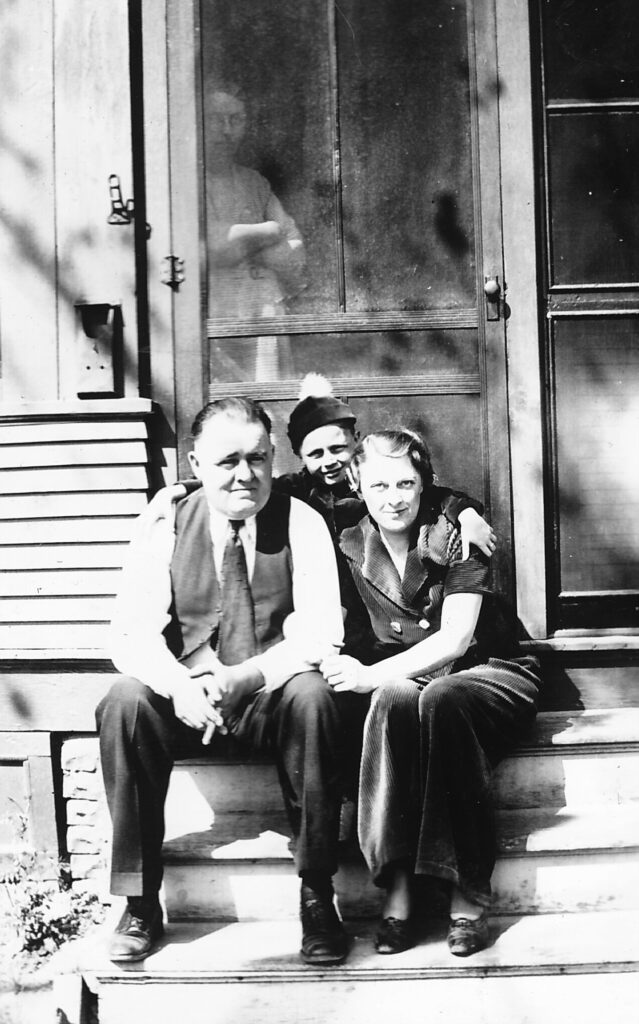
1935 – Left; The McNamaras in front of 15 Thomas, with Bertha looking on from behind the screen door. Below; Mac and Bobby (8). Below; During this time Mac (38) had a job as a salesman with the Brown & Williamson Tobaco Company. Note that you will rarely see a photo of Mac without a cigar in his hand.

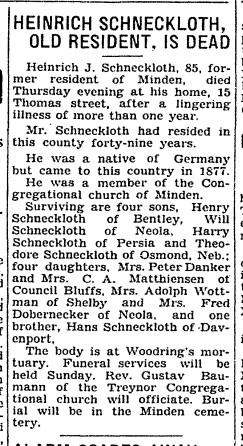
On January 10, 1935, Henry J. Schneckloth passed away at the age of 85. The Friday, January 11 Daily Nonpareil carried his obituary on page 5.


Henry and Amalia had a farm together in Minden, Iowa; about 30 miles northeast of Council Bluffs. So, it was fitting that they are buried together in the Minden Cemetery. Note the German words for father and mother on the gravestone. True to their roots.
Adolph and Bertha’s parents have all passed on. Their two daughters, Emma and Hilda, and their eldest son, Grant, are all married, and it would not be long before their youngest, 21-year-old Virgil, would be on his own.
With Henry gone, the economy stalled, young Bobby’s heath issues, and Adolph is now 63 years old…well there was a lot to think about in terms of what would be next for these folks.
1936 – The Visit
This story is primarily about Adolph and Bertha Matthiensen, but it’s hard to tell their story without including some other people; notably Mac, Hilda and Bobby, and the Hirsch, Rubin and Steinberg families.
You might ask, who are the Hirsch, Rubin and Steinberg families? Well, I did anyway.
As it turns out, they are folks that may have been a big part of why members of the McNamara and Matthiensen families now live in California.
Presumably, on the invitation of Mattie Steinberg, Mac, Hilda and Bobby took a trip to Los Angeles, California. This was a big deal for them back then. Hilda put some photos and other memorabilia from that trip into a scrap book, which were helpful in putting together this story. I’m sharing a few of those things here to help tell an important backstory that would have an impact on Adolph and Bertha’s future.
Before we go on, we first have to jump ahead to the end of that trip to examine one item among the Hilda’s memorabilia. For me, it was an eye-opening discovery.
Glued onto a page of Hilda’s scrapbook is an envelope with the following handwritten on the outside:
For the McNamaras
Aboard the 805
From Los Angeles
Sunday Eve. July 12 – 1936
The “805” refers to the time of the train that Mac, Hilda and Bobby were catching from Central Station in Los Angeles to return to Iowa. In that envelope is a two-page handwritten letter. It reads,
Dear Hilda, Mac and Bobby,
Your long awaited visit to California has finally been realized and now it must end at least for the time being. We hope you have enjoyed spending the short time with us as much as we have enjoyed being with you.
We hope you will see your way clear that at some later date you will be able to make your home in sunny California. As far as health is concerned, we are sure you will find this the ideal place. Financially – well, it is most important but I think if you are all healthy and happy, you (Mac) can work that out!
The accompanying package contains a few delicacies from the Hirschs, Rubins and Steinbergs. You will be able to partake of some on your way home, and some you may have to keep until you get home.
We thought you might also enjoy having the few enclosed snaps.
We hope your trip home will be enjoyable and interesting. We send our personal regards to each and everyone who might remember us and who are interested.
When you abord the train this evening you (plural) are taking with you loads of love and best wishes for good health and happiness, and hopes of your returning again for a visit if not to become a resident here.
Lovingly yours,
The Hirschs, Rubins and Steinbergs
Friendship is a beautiful thing.
Of friendship there are songs we sing;
Friends whose love comes from the heart,
Find it very difficult to part.
Words and music by Mattie Steinberg
Los Angeles, Calif.
July 12 – 1936
The person who wrote the letter (I presumed to be Mattie Steinberg) obviously had known Hilda and Mac from Council Bluffs. Also note that she must have known about Bobby’s health issues. It’s a touching and deeply personal letter full of friendship and love. After reading this beautiful letter, and now knowing how important these people were to my grandparents, and realizing their role in the whole story of this trip, I just had to find out more. Evidence was thin, so I thought I had little to no chance of figuring it out.
There were other clues in the scrapbook that told the story of both this July 1936 trip to Los Angeles and what Mac, Hilda and Bobby saw and did, and who and how Mattie Steinberg et al might be related to them. There were photos, small notes that provided first names of some of these family members, a couple of newspaper clippings.
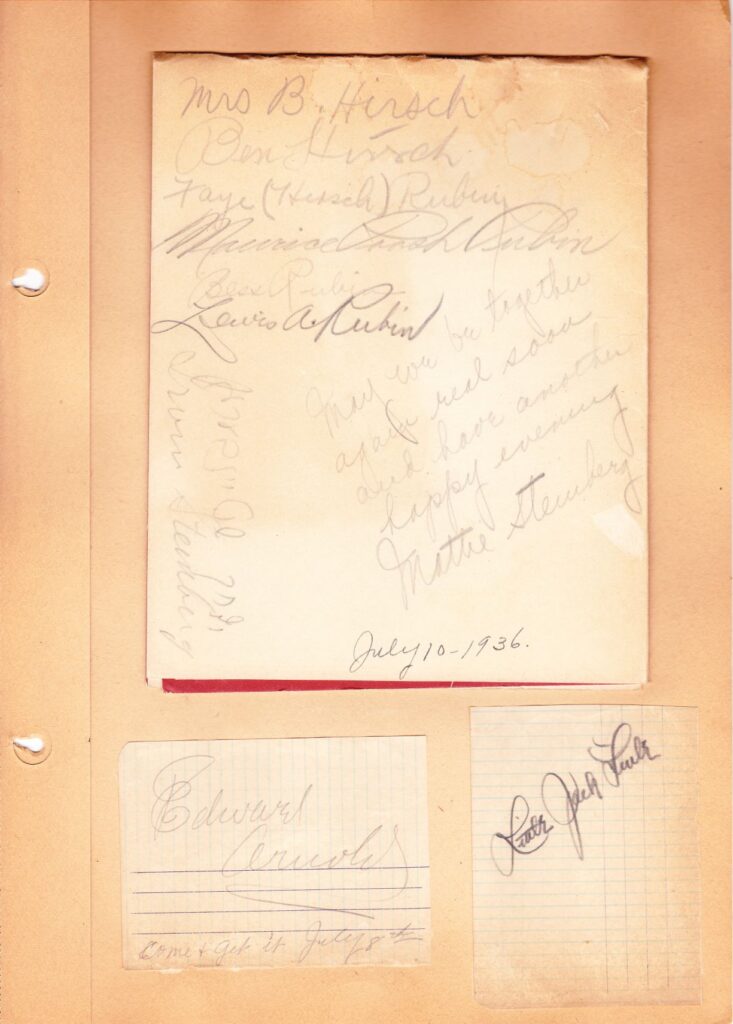
For example, there this menu from the “Biltmore Bowl” that Hilda had glued into her scrapbook. It was folded in fourths and on the exposed side all the folks who went that day wrote their names on the back of the menu.
Mattie Steinberg has signed the menu and added the note, “May we be together again real soon and have another happy evening.”
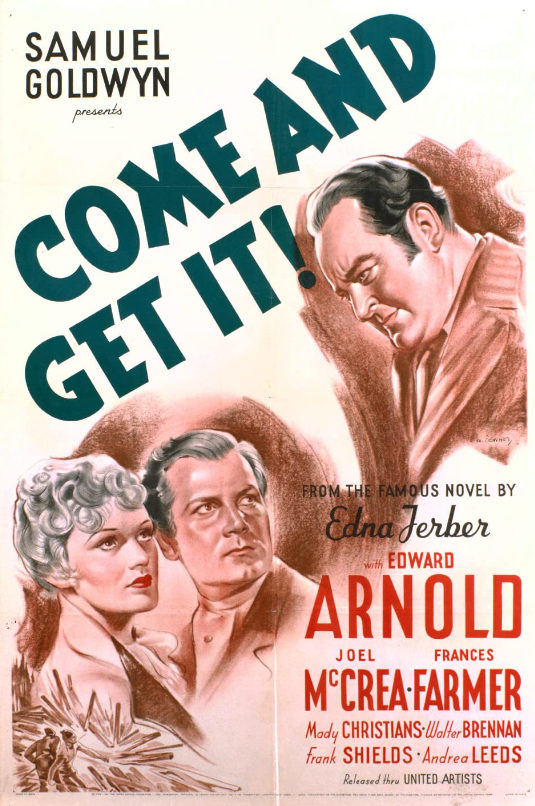 Also note that on the above scrapbook page, Hilda collected a couple autographs. The one on the right I could not decipher, but the other one is Edward Arnold. You can barely make out the words “Come and get it” and “July 8th” written under the name. Edward Arnold was a big movie star back then, and he was starring in the newly released 1936 movie “Come and get it”.
Also note that on the above scrapbook page, Hilda collected a couple autographs. The one on the right I could not decipher, but the other one is Edward Arnold. You can barely make out the words “Come and get it” and “July 8th” written under the name. Edward Arnold was a big movie star back then, and he was starring in the newly released 1936 movie “Come and get it”.
This movie is available on Amazon Prime, so I watched it. It also stars Walter Brennan who plays a Swedish logger. His Swedish accent in the movie is just way over the top.

The Biltmore Bowl was a huge lavish ballroom that was once part of the Biltmore Hotel. The interior was two stories tall. Eight Oscar ceremonies in the 30s and early 40s were held there. In the 1950s, it suffered a devastating fire and was never rebuilt.
I was able to find some other information online by leveraging the search capabilities on Ancestry.com, and a few other sources such as old online copies of the Omaha Nebraska publication, “The Jewish Press”, as well as this clipping from Hilda’s scrapbook (below).

That’s Mattie Steinburg on the far right. Note how in those days all married women are identified as wives of the husband by Mrs. or “MMES” rather than their own names.
All in all, it took me several days to eventually find the key to unlocking the relationship between the McNamara family and these other folks.
The short story goes like this.
Before Mattie Steinberg (who penned the above letter) married Irving Steinberg, she was Mattie Stella Hirsch. Her parents were Benjamin and “Tony” Hirsch. It turns out that the Hirsch family were the proprietors of “Benjamin Hirsh”; a “women’s ready to wear” store located at 406 W. Broadway in Council Bluffs, Iowa. This is the very same store that Hilda (then 21 years old) started working at as a saleslady in 1921, and stayed in their employment for about 3 years. The store was just a mile down the road from where Hilda was living with her parents, Adolph and Bertha, at 510 Pierce Street.
See: “PPP – Bertha and Christian Adolph Matthiensen – Part 1 Iowa” at
https://www.mmcjournal.com/ppp-bertha-and-christian-adolph-matthiensen-part-1-iowa/

Ben and Tony from their early days in in the Midwest.
Note: Benjamin’s wife’s name was in fact spelled “Tony” in all of the early documents I found, including their Omaha, Nebraska wedding license (1901), and all the US Census reports right up to 1930. Although, the 1922 Council Bluffs directory does list her name as “Ionia”, this was the only document that I saw that did so. The first and only document that I could find that had her name spelled as “Toni” was the 1938 Los Angeles phone directory (which may have been an error). She must have gone by the name “Tony” because that is what is on her grave marker at the Hollywood Forever cemetery (Beth Olam Mausoleum, M-10).
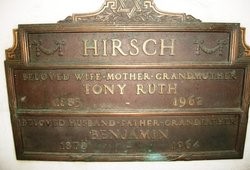
For reasons I could not find, the Hirsch family closed their store, and they would then move to Los Angeles on July 10, 1924. This explains why Hilda started working at a different woman’s clothing store at that time.
I will note here that it is no surprise to me that Hilda made a great impression on the Hirsch family, and that she and Mac became friends with them. Hilda was known for her love of friends and family.
After moving to Los Angeles, Benjamin Hirsch started a new career as a stock broker.

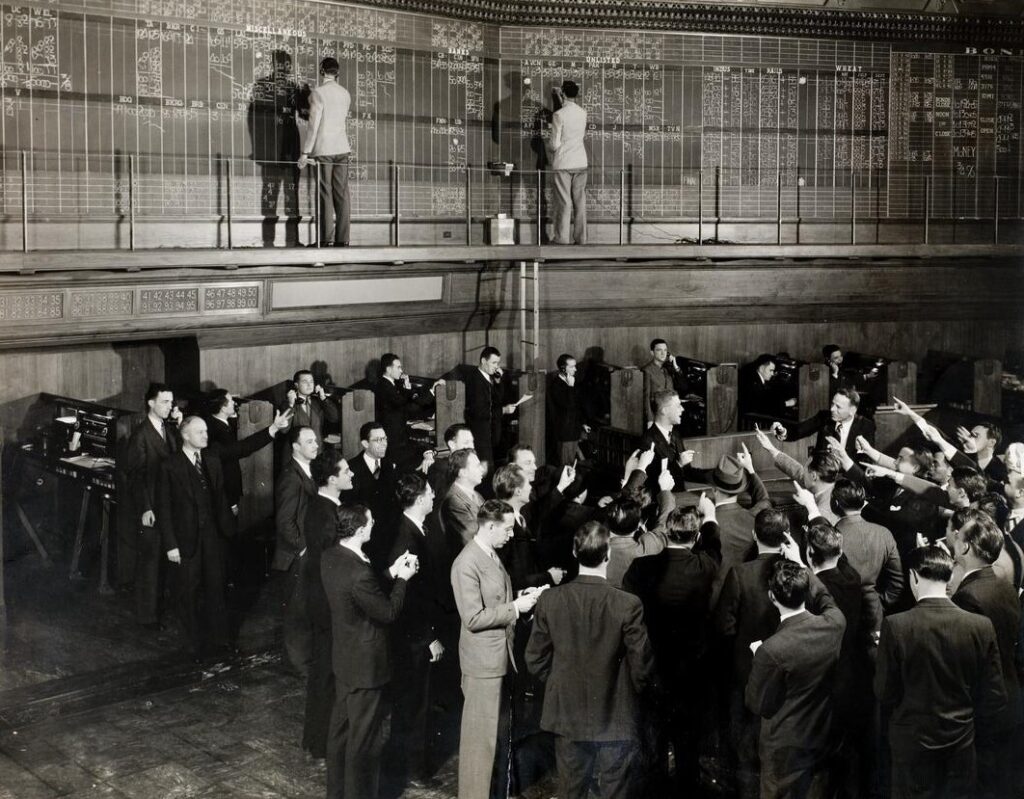
Photos from the internet of the Los Angeles Stock exchange in 1938. It was located at 618 South Spring Street; about 10 miles from the Hirsch’s Los Angeles home at 428 Sherbourne Drive.
Ben Hirsch embraced the 20’s stock market frenzy by getting into the trading business, and somehow made it through “The Crash”. From what I could tell, he and his family were doing pretty well by 1936.
Mac, Hilda and Bobby saw the sights….
Catalina

Page out of Hilda’s scrapbook from their trip to Catalina. Top; Bobby and Mac (doing what looks like a Truman Capote impersonation) on the upper floor of the Catalina “Casino”. Below; a photo of the Casino taken from the boat.
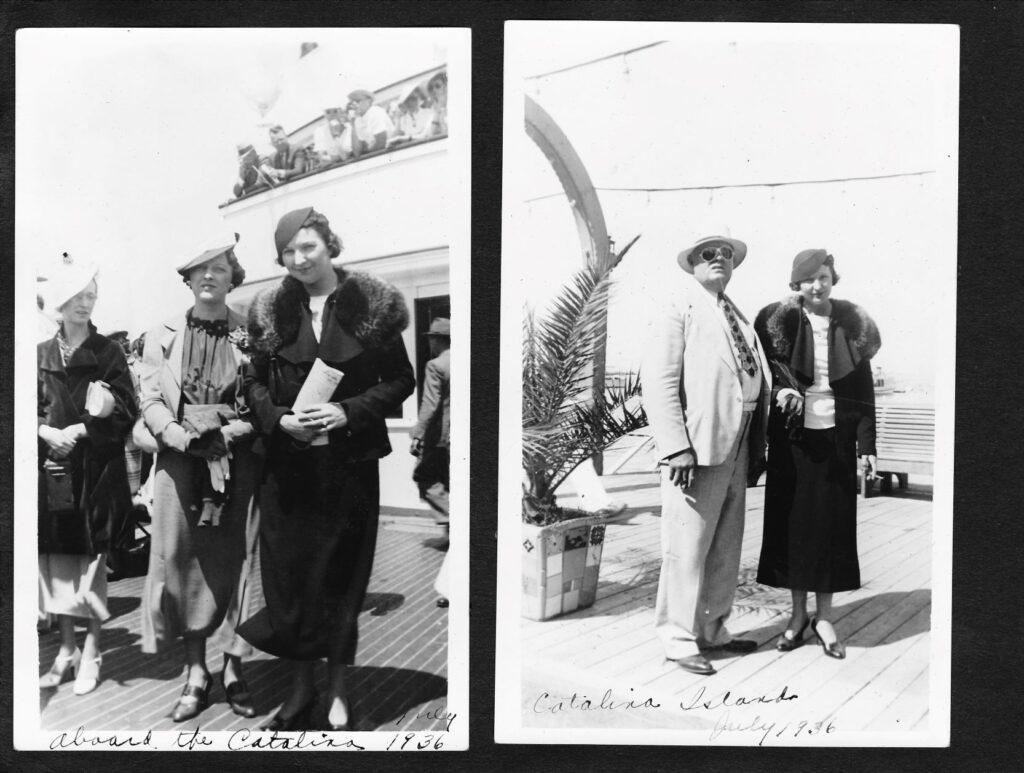
Above; Hilda and Mac posing on the Avalon dock with a woman I (try as I did) cannot identify. I don’t think it is Mattie, but it is most certainly one of the other folks that hosted their visit to California.

They also visited Ocean Park Pier, which was a huge amusement park and entertainment center on the beach in Santa Monica for many years. It was torn down and replaced the Disney-like Pacific Ocean Park.
As the letter noted, Mac, Hilda and Bobby took the train back home on July 12, 1936. Apparently, this trip sold them on the idea of moving to California.
1937 – Gone to California!
So, they did in December of 1937. And when they arrived and settled into their first place at 738 North Kilkea Drive (near Melrose and Crescent Heights) they took some time to explore around their new home.
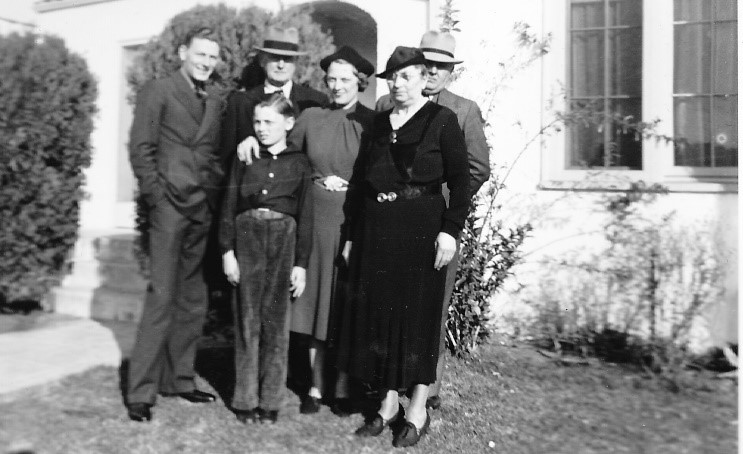
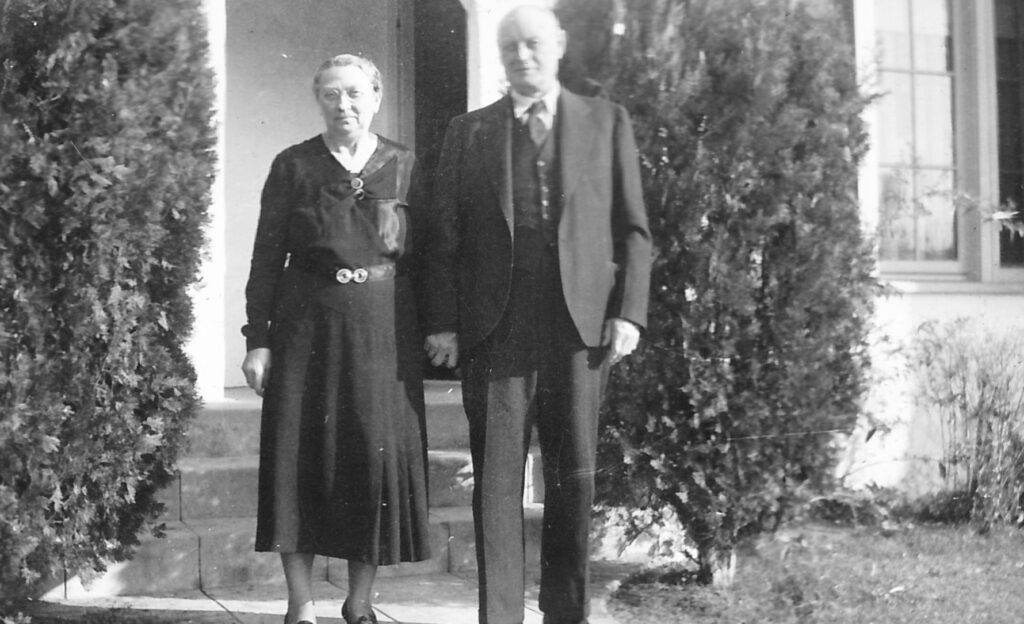
Left; Virgil, Adolph, Bobby, Hilda, Bertha and Mac and on the right Bertha and Adolph in front of their new home in Los Angeles.
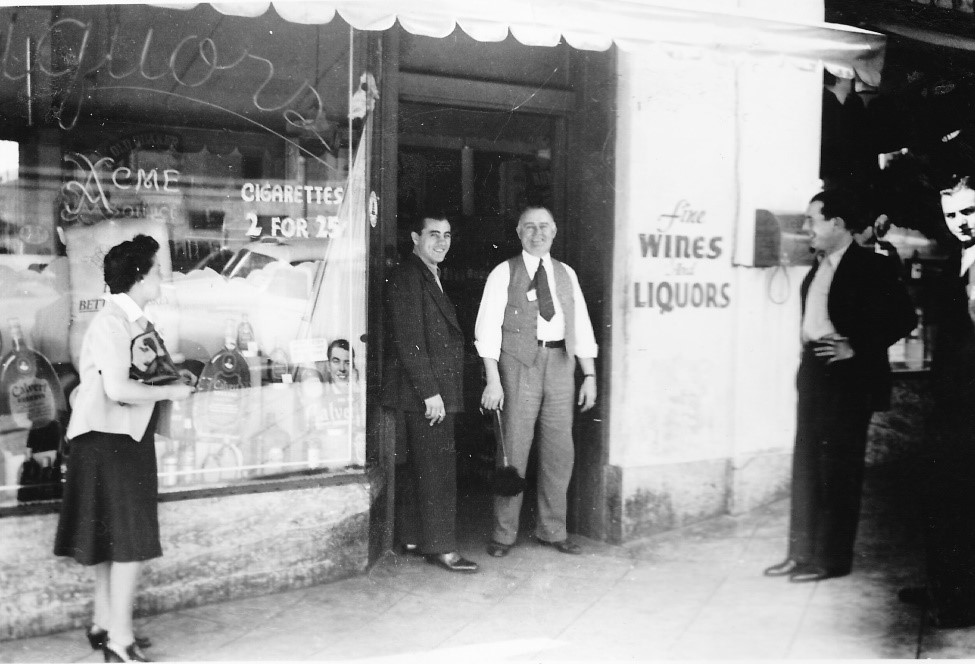
Mac did land a job as the manager of a liquor store.

Bobby was looking heathier and happier.
In April of 1938 they moved to another place at 254 S. Rexford Drive, Beverly Hills.


Left; in a rare reversal we have Hilda not smiling and instead Bertha is grinning. Right; There is Adolph, Bobby with Bertha right behind him. Don’t know the people on either side of Hilda (maybe Irving and Mattie Steinberg?).
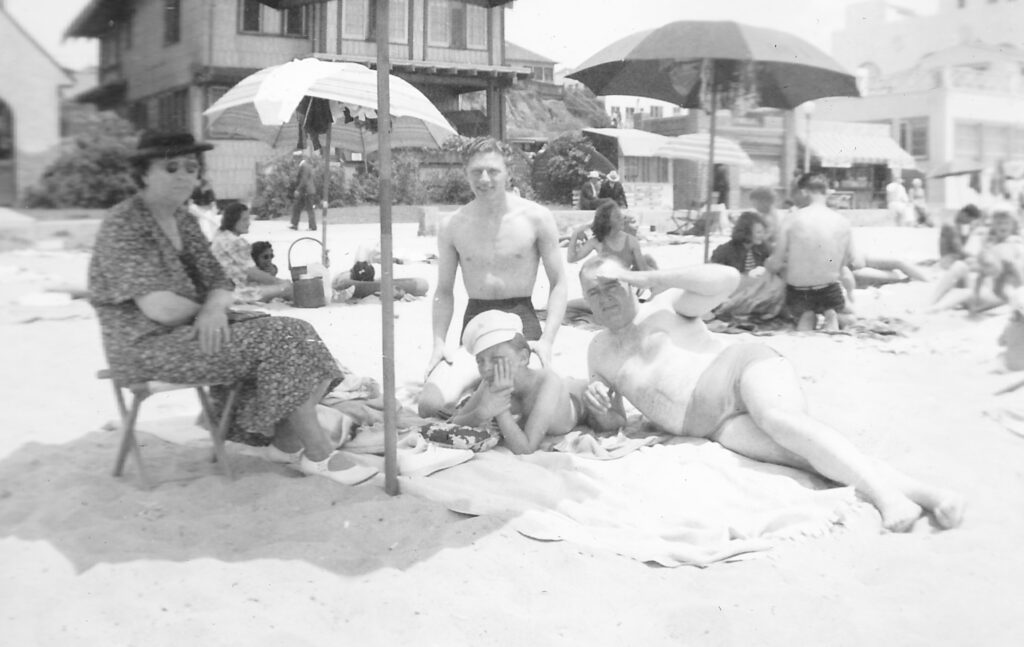
Life was good. Bertha, Virgil, Bobby and Mac at the beach in the summer of 1938.
Adolph and Bertha’s Adult Children
Emma
Emma did not migrate to California. She married Walter Harry Petersen and with him had two daughters and a son, Walter Harold Petersen (Harold).
Grant
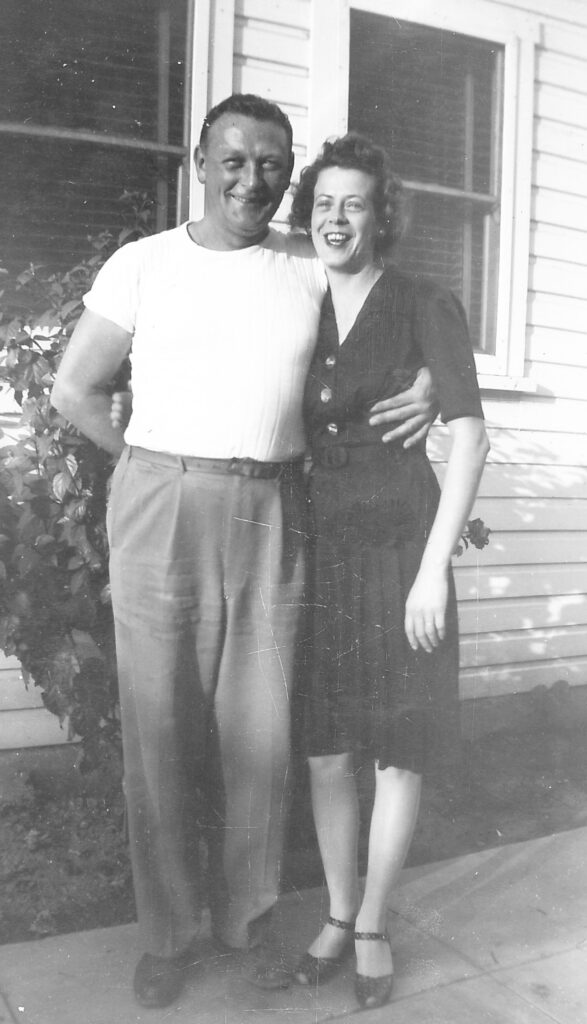
Grant and his first wife Ardieth divorced sometime between 1931 and 1933.
Gant married his second wife, and Iowa native, Edna Irene Rodenburg on January 11, 1934. They moved to Los Angeles about the same time as Adolph and Bertha. I have not nailed this down yet, but sometime after 1950 Grant and “Eddy” moved to Las Vegas.
Circa 1950 Grant and Eddy in Los Angeles. Though my only memories of them are from my early childhood, when I saw this photo I recall thinking, yep that’s Grant and Eddy! Something tells me they were a lot of fun to be around.
Virgil
Virgil also moved to California about the same time as his parents. There he would meet the love of his life, Bessie May Tompkins. Virgil would go on to serve in the US Navy during WWII. He would return home and he and Bessie would go on to have two sons and a daughter; Robert G. “Bobby” (October 28, 1946), Jayne Sue (May 29, 1949), and Terry G. (August 8, 1956).
Hilda
As we know, Mac, Hilda and Bobby pioneered the move to live in Los Angeles.
More on these good folks in another PPP.
Bertha and Adolph in Los Angeles
Since moving to Los Angeles, Bertha and Adolph were living as a senior retired couple.
In December of 1942 Bertha, at age 68, applied to the Iowa State Department of Health for a Delayed Birth Certificate. Adolph, at age 71, did likewise in January 1943.
This is one of those things that is commonly found when looking up information on folks who were born at home before 1900 (and sometimes later) in rural areas. They may have a baptism certificate, but there is no official birth certificate.
It is not quite clear why, after all those years, they would need a birth certificate. However, there is one clue. The Social Security Act was signed into law by President Roosevelt on August 14, 1935, so perhaps Adolph and Bertha could qualify for Social Security benefits, which would most likely require a proof of citizenship. Thus, the birth certificate would be needed in order to receive Social Security benefits.
Bertha’s sister Mini Danker signed and submitted the affidavit for Bertha, and family friend Robert Buchtel filed the paperwork for Adolph. Seeing scans of these forms (and others like it) is amazing. On Bertha’s form it even named the midwife (Mrs. Schluyter) who delivered her.
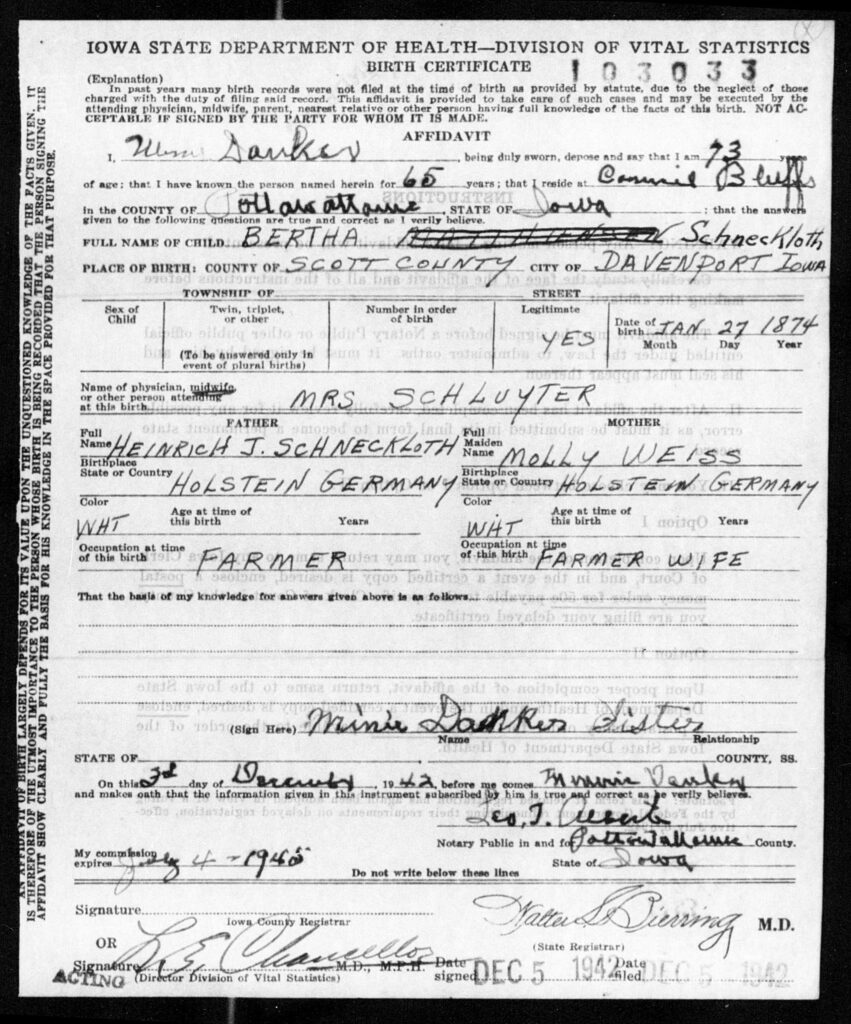
The McNamara family and Bertha and Adolph Matthiensen moved around the LA area (six different locations) before they finally moved into an apartment complex at 11304 Stanwood Drive, LA 66 in December 1949.

Circa 1950 Bertha (~76) and Adolph (~78) in the courtyard of their apartment complex in west LA at Stanwood Drive and Sawtelle Avenue.
On December 6, 1950, Mac suddenly died of a heart attack. He was 53 years old.
In September 1951 Bobby (23 and now answering to Gerry) married his sweetheart, Louise Kerbrat (22).


Summer 1954 – Adolph (82) and Bertha (80) holding yours truly in the courtyard of the apartment complex where they lived on Stanwood Drive and Sawtelle Boulevard in West Los Angeles.
One of my earliest memories is being in their apartment. It was a small modest and neatly kept one bedroom. I recall Adolph sitting in a rocking chair in a corner of the dining area. From this spot, he could see through a door directly into the kitchen while Bertha prepared meals. I recall that Adolph seemed to just sit and stare ahead. I got the distinct feeling he was not really there. I believe he may have suffered a stroke or perhaps some sort of dementia.
Being about three years old, I was able toddle around and would stand in the kitchen with Bertha; sometimes steadying myself by holding onto her skirt or apron. It is a faded memory, and it is only a couple seconds long, but I can still feel the fabric of her clothing and see her smiling face when she leaned over to look down at me.
For a time, My Mom and Dad lived in the apartment across the hall from Adolph and Bertha. Mom said that if Bertha heard me crying, she would just no-knock let herself into their place and pick me up to comfort me. She would then say to them (in what my Mother described as a mix of midwestern/German accents) something like, “You will not treat this child like that!”; in effect accusing them of neglecting me. My mother described Bertha holding me over her shoulder and patting me on my back in such a forceful way that my parents would jokingly say to one another that I probably stopped crying soon thereafter out of self-preservation. Mom was probably pretty peeved at Bertha at the time, but she always laughed about it when she told this story to us.
Those apartments have been gone for years now. They have been replaced with newer apartments. The newer ones are probably better in many ways, but I doubt there is still the wide-open grassy courtyard where folks would meet and have a picnic, or hang their washed cloths out to dry in the warm California sun like Bertha used to do.
1956 – 60th Wedding Anniversary!
Bertha and Adolph were married to one another on October 7, 1896, and so in 1956 they celebrated their 60th wedding anniversary.
The Council Bluffs newspaper carried the story. While researching this story I happened to find their wedding photograph.

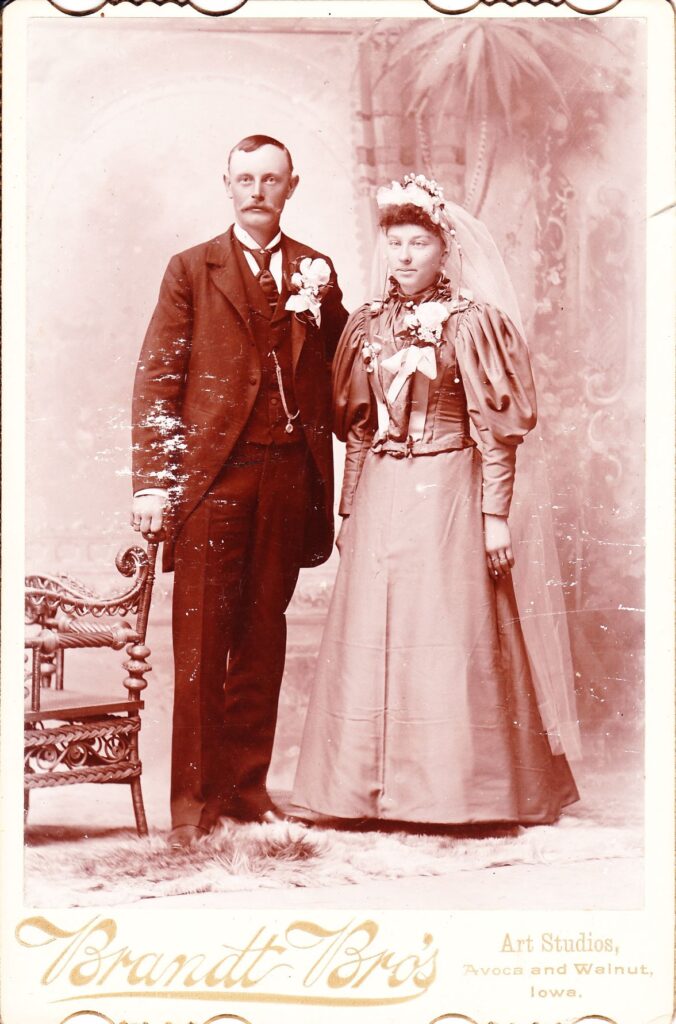
On 25 May, 1959, Adolph Matthiensen passed away. He was 87 years old.
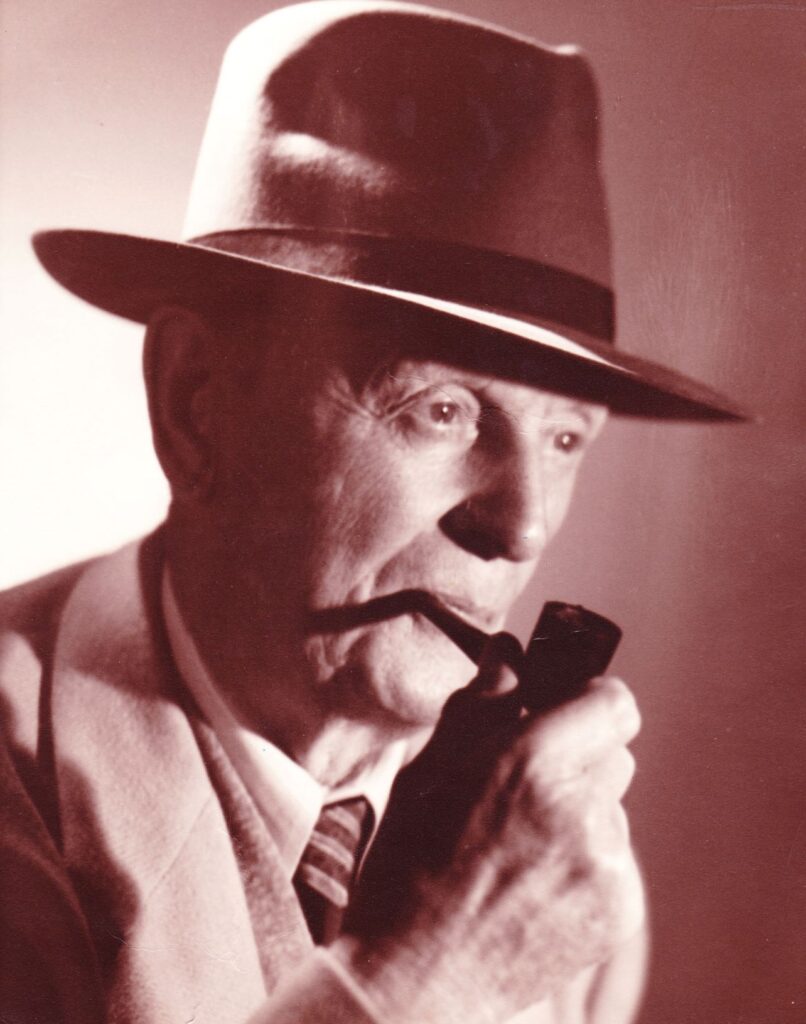
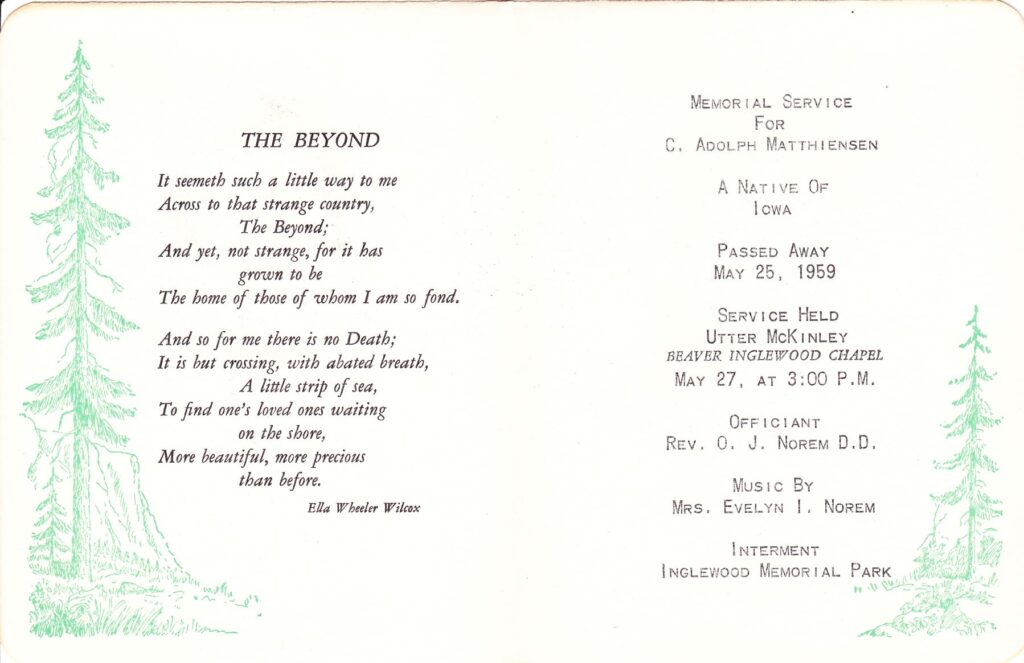
On March 18, 1961, Bertha (Schneckloth) Matthiensen passed away. She too was 87 years old.


Newspaper item from the Council Bluffs Nonpareil
Much Love and thanks to both of them.
Postscript
This PPP was to tell the story of Adolph and Bertha Matthiensen. I have to admit I cried a few times while writing it.
Theirs was an amazing life, and it was a privilege to research and write about it. But there is this larger overall theme that was emerging in the background all the while I was writing.
The McNamara family in America began when the parents of my great-great-grandparents, Henry McNamara and Bridget McNerney, immigrated from Ireland in 1843. They were among the 780,719 Irish that immigrated to the US between 1841 and 1850. In the 1840’s, the Irish made up about half of all immigrants that came to the US. The reason for this sudden influx of Irish was largely due to the potato blight which destroyed this primary food source of their diet. This resulted in a terrible famine throughout Ireland. These people were mostly dirt-poor, uneducated peasants, who for years had been persecuted for their religion, Catholicism. Their travel to this country was not an easy one.
The Hirsch family in America began when the parents of Mattie (Hirsch) Steinburg, Benjamin Hirsch and Tony Bernstein, immigrated to the US around 1890. They were Ashkenazi Jews from Poland and Russia. The brief research I did to look into the reasons for Jewish immigration from these countries to the US revealed a centuries-long history of discrimination and persecution of these people living in the lands ruled by Russia which included Poland, Latvia, Lithuania, and the Ukraine. Some reforms were initiated, but by the 1860s and 1870s, it became clear that the troubles would never really improve, so many chose to leave. From 1880 to 1920, large numbers of Jewish immigrants from these lands came to America for a better life. And like the Hirsch family, some came and settled in Iowa and Nebraska.
The Matthiensen family in America began when August and Lise (Hopp) Matthiensen, and Henry and Amalia (Weiss) Schneckloth immigrated to the US in the 1860s from the long-disputed Schleswig-Holstein area of what is now Germany. Schleswig-Holstein was a geopolitically disputed region that on at least two occasions had Denmark and Germany warring over who owned it. August fought in one of those wars. Germany eventually won out, and they then instituted discriminatory laws against the Danes that lived there. Because of the protracted wars, the economies of both Denmark and Germany were in a shambles. I often wonder how these people felt about this struggle in their homeland, considering that Adolph’s parents and grandparents were a mixed German/Danish couple, as was he and Bertha.
All three of these families have one thing in common; they made the incredibly difficult decision to leave their homeland where there was overwhelming suffering and strife for a chance to build a new life.
All the people in this story were not that far removed from that generation of people who made this difficult and risky move; leaving everything behind, and taking a long and dangerous journey that included a transatlantic crossing on wooden sail-powered ships, only to arrive in a strange country for which they could not speak the language. But in spite of these odds, they made it.
Perhaps it was their experience with so much suffering and strife that inspired a desire for another kind of change, one that had them seek out new bonds of community and friendship, even with those of cultures that they knew little to nothing about.
Next time we feel tested by one of our modern first-world problems, like the internet going down, or when the sink gets plugged up, it will do us good to recall the times these folks lived in and what they went through and accomplished. Maybe the next time we meet with family or friends of this multicultural country, it will do us good to remember these things, and be thankful that we have them.
Happy Thanksgiving to all,
MMc
What an incredible journey and wonderful story. Again, I’m completely blown away with all the research you are doing for these stories. Thank you for taking the time and share the results with us ❤️
Your work is inspiring, I enjoy reading it, please keep it up.
We do have it so much easier than the generations before us. Perfect timing to get to read this, the morning after Thanksgiving.
Hi Steve. You have always expressed an sincere appreciation for these stories. I hope to be more active in my writing in the future, as I will probably be retiring (or as I like to call it, Refireing”) sometime in 2023. Hope you had a nice Thanksgiving, and the holidays ahead of us. With Gratitude, Mike
As usual Mike you’ve brought these people’s lives into ours in a loving, vibrant way. Thanks again. 😎
Thank you Paul!
This is just awesome how youre able to create their stories out of what was left behind. We all have a story.